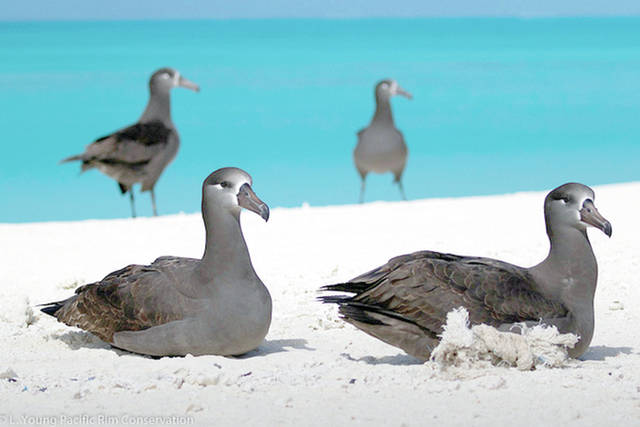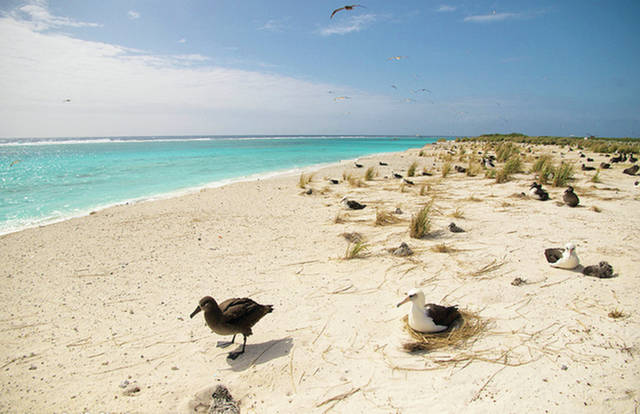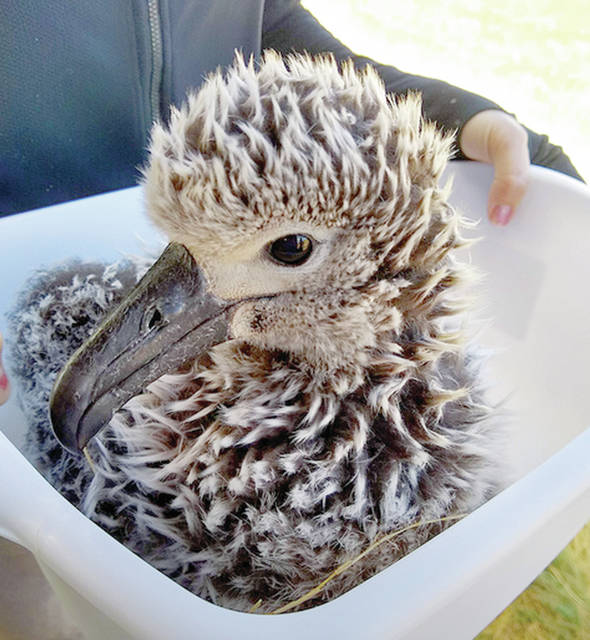LIHUE — While laysan albatross chicks on Kauai are just about to starting to outgrow their nests, 25 of their cousins are getting used to something new far from their own birthplaces — about 1,300 miles away, according to researchers who recently translocated a group of black-footed albatross chicks from Midway Atoll to the James Campbell National Wildlife Refuge on Oahu.
“We are thrilled that the Refuge can provide a safe place and a new home for this species on Oahu,” said Glenn Klingler, Refuge Manager at James Campbell. “This translocation is another step toward creating a new colony of albatross in the main Hawaiian Islands and ensuring the albatross will be protected for future generations.”
Black-footed albatross are one of the three albatross species seen regularly in the north Pacific and is known for breeding in the Northwestern Hawaiian Islands, according to the Kauai Seabird Recovery Project.
The species doesn’t breed on Kauai — it’s the laysan albatross that nests on The Garden Isle — but it does have small breeding colony on Lehua Island and Niihau. KSRP says they are regularly seen from Kauai shores from November through May.
They’re listed as endangered, whereas Laysan albatross are listed as near threatened. Both species face some of the same threats to existence, however — threats like longline fishing and plastic consumption.
The translocation of the black-footed albatross chicks will help foster new colonies on Oahu and contribute to a growing population.
“Midway Atoll is home to one of the largest black-footed albatross colonies in the world,” said Midway Atoll Refuge and Memorial Project Leader Bob Peyton. “As conservation managers, it is important we use good science to evaluate other options that might protect these seabirds into the future.”
Moving from Midway to Oahu is one of the longer trajectories for translocation; on Kauai these types of projects have been ongoing for several years. Pacific Rim Conservation reports from 2015-2017, 50 laysan albatross chicks were translocated from Kauai’s Westside to James Campbell on Oahu, as well as to certain areas on Kauai’s North Shore.
That project is due to the nesting colony’s proximity to a runway, posing a collision hazard for both pilots and the birds.
Throughout the entire program, PRC says 46 laysan albatross have successfully fledged and the first chick from the 2015 group returned to land in 2018.
In 2017-2018, PRC and partners moved 40 black-footed albatross chicks from Midway and Tern Island to James Campbell, of which 36 fledged.
“Refuges like Midway Atoll and James Campbell provide the healthy habitat that black-footed albatross, and other seabirds, need to thrive,” Peyton said.
The translocation site at James Campbell is high enough that it is less at risk from rising sea-levels and increasing storm surges. It also has a fence that ensures a predator-free area with protection from non-native predators that are prevalent in the main islands, such as mongooses, rats, and feral cats and dogs.
The three-week-old chicks will be fed a diet of fish and squid and closely monitored by biologists for four to five months, until they are able to fly out to sea and feed themselves.
“This translocation is another step toward creating a new colony of albatross in the main Hawaiian Islands and ensuring the albatross will be protected for future generations,” Peyton said.




